P1609000
Phytomenadione
European Pharmacopoeia (EP) Reference Standard
Synonym(s):
Vitamin K1, 2-Methyl-3-phytyl-1,4-naphthoquinone, 3-Phytylmenadione, Phylloquinone, Vitamin K1(20)
About This Item
Recommended Products
biological source
synthetic
grade
pharmaceutical primary standard
Agency
EP
API family
phytomenadione
form
solid
manufacturer/tradename
EDQM
technique(s)
gas chromatography (GC): suitable
liquid chromatography (LC): suitable
refractive index
n20/D 1.527 (lit.)
mp
−20 °C (lit.)
density
0.984 g/mL at 25 °C (lit.)
application(s)
pharmaceutical (small molecule)
format
neat
storage temp.
2-8°C
SMILES string
O=C(C1=CC=CC=C21)C(C)=C(C/C=C(CCC[C@@H](CCC[C@H](C)CCCC(C)C)C)\C)C2=O
InChI
1S/C31H46O2/c1-22(2)12-9-13-23(3)14-10-15-24(4)16-11-17-25(5)20-21-27-26(6)30(32)28-18-7-8-19-29(28)31(27)33/h7-8,18-20,22-24H,9-17,21H2,1-6H3/b25-20+/t23-,24-/m1/s1
InChI key
MBWXNTAXLNYFJB-NKFFZRIASA-N
Looking for similar products? Visit Product Comparison Guide
General description
Phytomenadione is a methyl napthoquinone derivative, and a naturally occurring fat soluble vitamin K1. It plays a key role in the maintenance of normal blood clotting mechanism and also in the prevention of hemorrhagic disease in newborns.
Application
Packaging
Other Notes
related product
Storage Class Code
11 - Combustible Solids
WGK
WGK 1
Flash Point(F)
Not applicable
Flash Point(C)
Not applicable
Choose from one of the most recent versions:
Certificates of Analysis (COA)
Sorry, we don't have COAs for this product available online at this time.
If you need assistance, please contact Customer Support.
Already Own This Product?
Find documentation for the products that you have recently purchased in the Document Library.
Customers Also Viewed
Our team of scientists has experience in all areas of research including Life Science, Material Science, Chemical Synthesis, Chromatography, Analytical and many others.
Contact Technical Service











